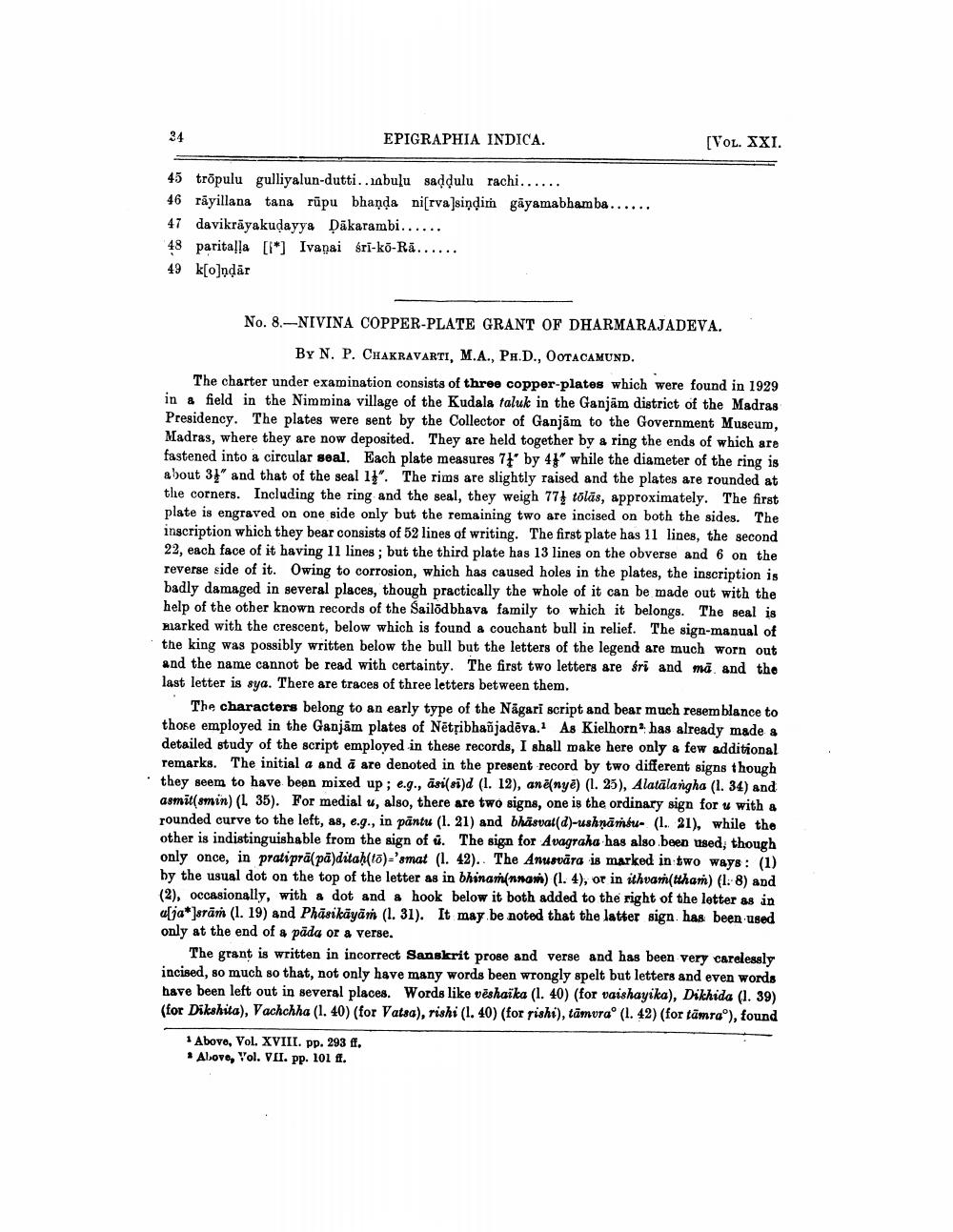________________
34
EPIGRAPHIA INDICA.
[VOL. XXI.
45 trõpulu gulliyalun-dutti..unbuļu saddulu rachi...... 46 rāyillana tana rūpu bhanda ni[rva]siņķiṁ gāyamabhamba...... 47 davikrāyakudayya Dākarambi...... 48 paritala [1*] Ivanai sri-ko-Ra...... 49 k[o]ndar
No. 8. --NIVINA COPPER-PLATE GRANT OF DHARMARAJADEVA.
BY N. P. CHAKRAVARTI, M.A., Ph.D., OOTACAMUND. The charter under examination consists of three copper-plates which were found in 1929 in a field in the Nimmina village of the Kudala taluk in the Ganjam district of the Madras Presidency. The plates were sent by the Collector of Ganjām to the Government Museum, Madras, where they are now deposited. They are held together by & ring the ends of which are fastened into a circular seal. Each plate measures 71 by 41' while the diameter of the ring is about 31' and that of the seal 11". The rims are slightly raised and the plates are rounded at the corners. Including the ring and the seal, they weigh 77 tõlās, approximately. The first plate is engraved on one side only but the remaining two are incised on both the sides. The inscription which they bear consists of 52 lines of writing. The first plate has 11 lines, the second 22, each face of it having 11 lines; but the third plate has 13 lines on the obverse and 6 on the reverse side of it. Owing to corrosion, which has caused holes in the plates, the inscription is badly damaged in several places, though practically the whole of it can be made out with the help of the other known records of the Sailodbhava family to which it belongs. The seal is marked with the crescent, below which is found & couchant bull in relief. The sign-manual of the king was possibly written below the bull but the letters of the legend are much worn out and the name cannot be read with certainty. The first two letters are sri and ma and the last letter is sya. There are traces of three letters between them.
The characters belong to an early type of the Nagari script and bear much regem blance to those employed in the Ganjam plates of Nētribhajadēva. As Kielhorn" has already made & detailed study of the script employed in these records, I shall make here only a few additional remarks. The initial a and à are denoted in the present record by two different signs though they seem to have been mixed up; e.g., asi(si)d (1. 12), anē nye) (1.25), Alatālangha (1. 34) and asmit(smin) (1, 35). For medial u, also, there are two signs, one is the ordinary sign for u with a rounded curve to the left, as, e.g., in pantu (1. 21) and bhäsvat(d)-ushņāṁsu- (1. 21), while the other is indistinguishable from the sign of ů. The sign for Avagraha has also been used, though only once, in pratiprä(påditah(to)-'smat (1. 42). The Amusvāra is marked in two ways: (1) by the usual dot on the top of the letter as in bhinamannam) (1.4), or in ithvarttham) (1: 8) and (2), occasionally, with a dot and a hook below it both added to the right of the letter as in asja*]srāṁ (1. 19) and Phäsikäyān (1. 31). It may be noted that the latter sign has been used only at the end of & pāda or a verse.
The grant is written in incorrect Sanskrit prose and verse and has been very carelessly incised, so much so that, not only have many words been wrongly spelt but letters and even words have been left out in several places. Words like vēshaïka (. 40) (for vaishayika), Dikhida (1. 39) (for Dikshita), Vachchha (1. 40) (for Vatsa), rishi (1. 40) (for rishi), tāmura° (1. 42) (for tāmra'), found
1 Abovo, Vol. XVIII. pp. 293 ff. * Alove, Vol. VII. pp. 101 ff.




